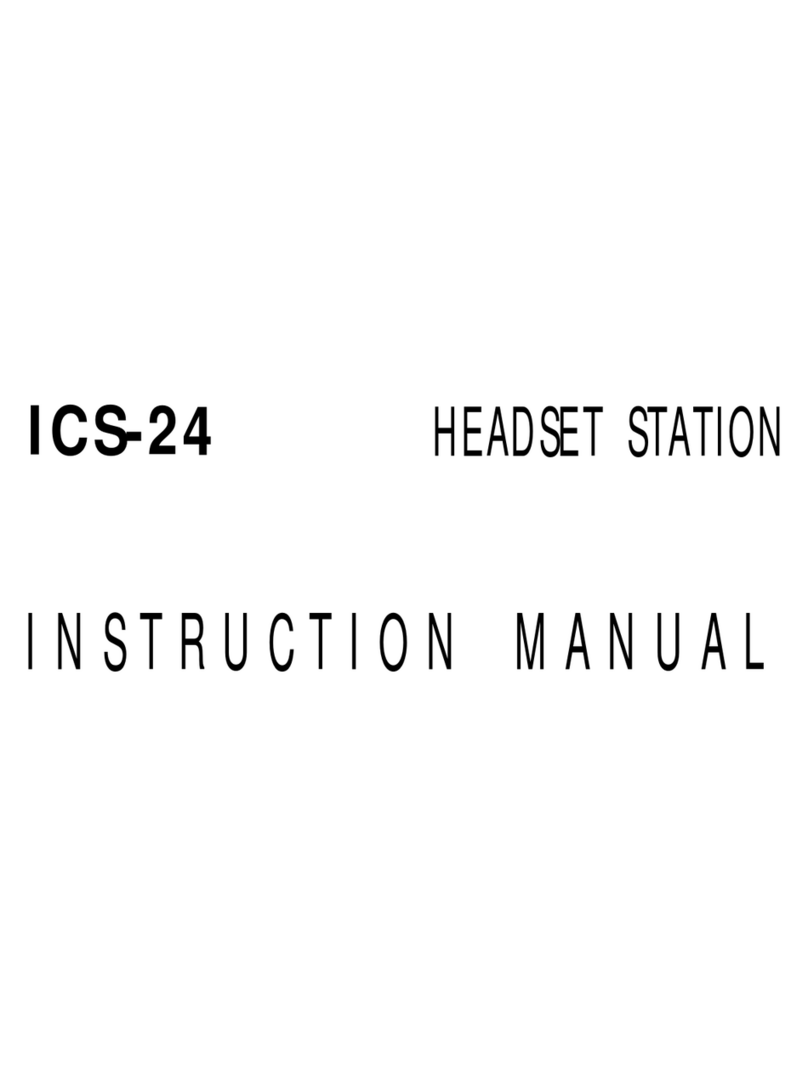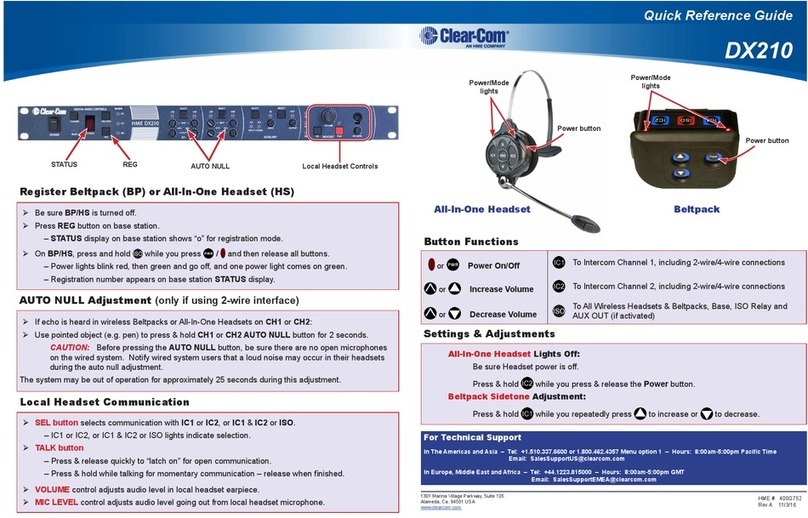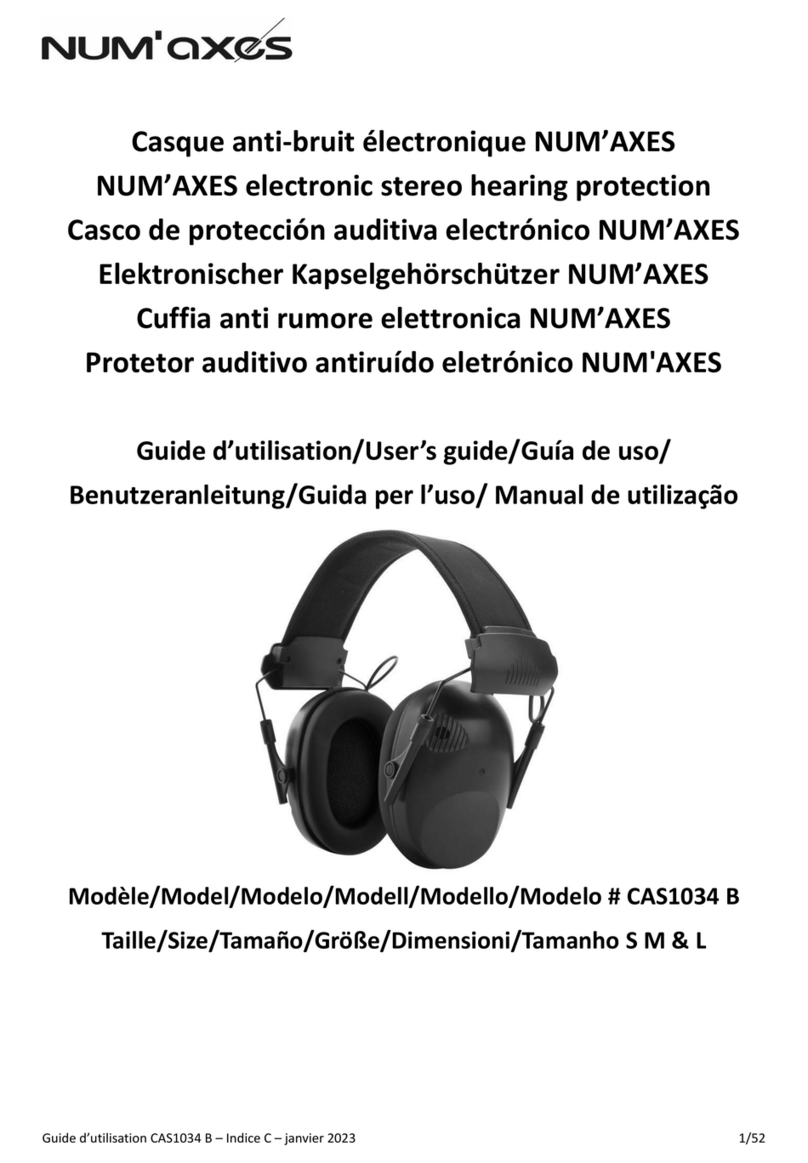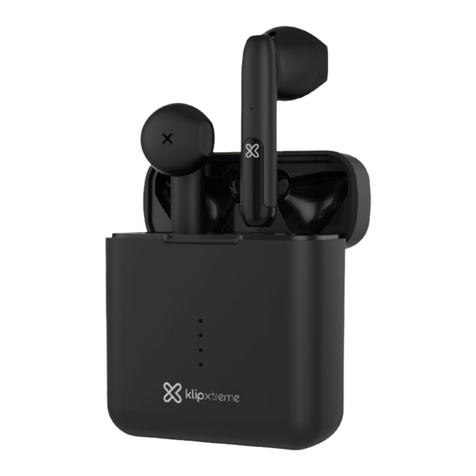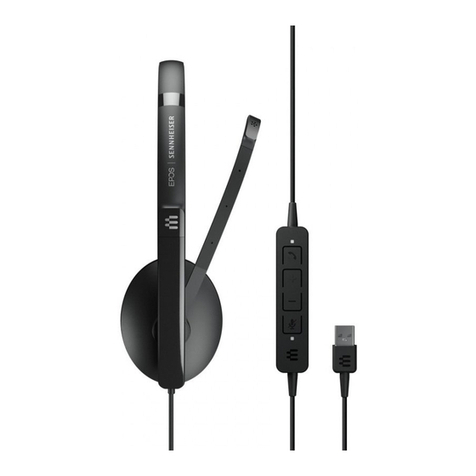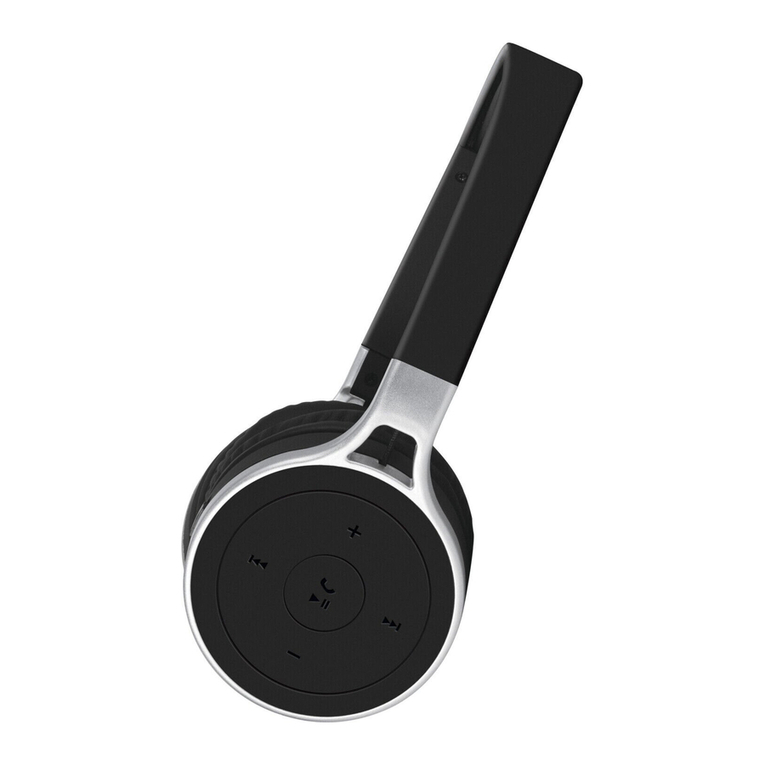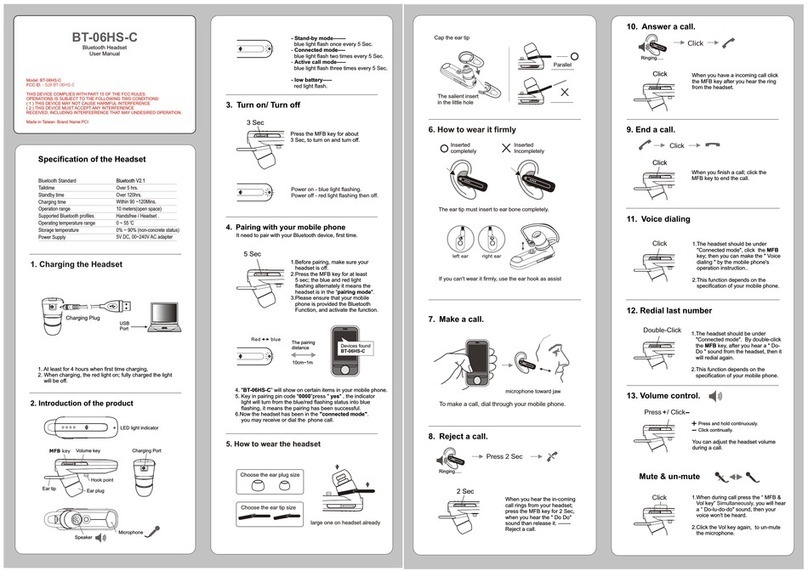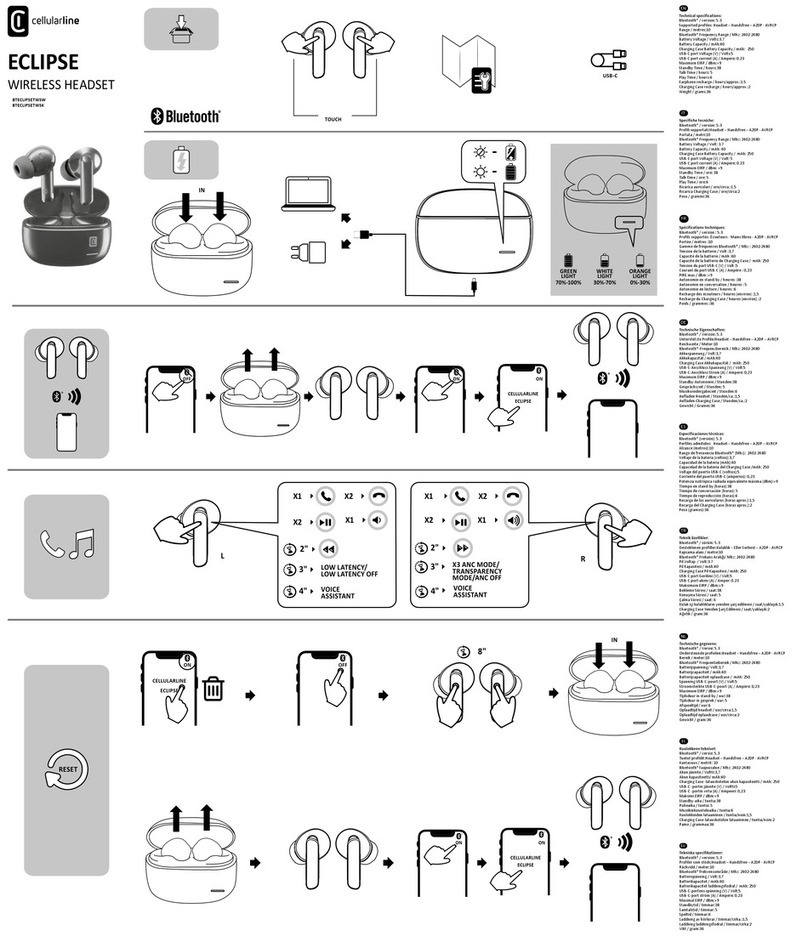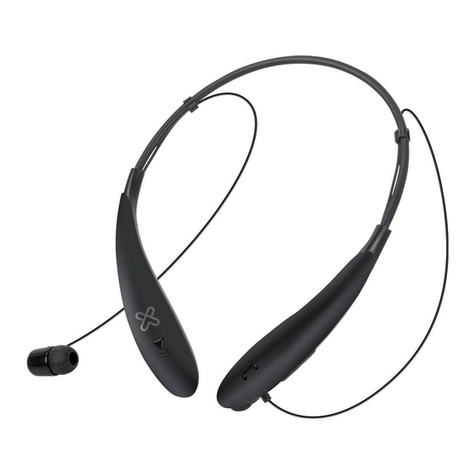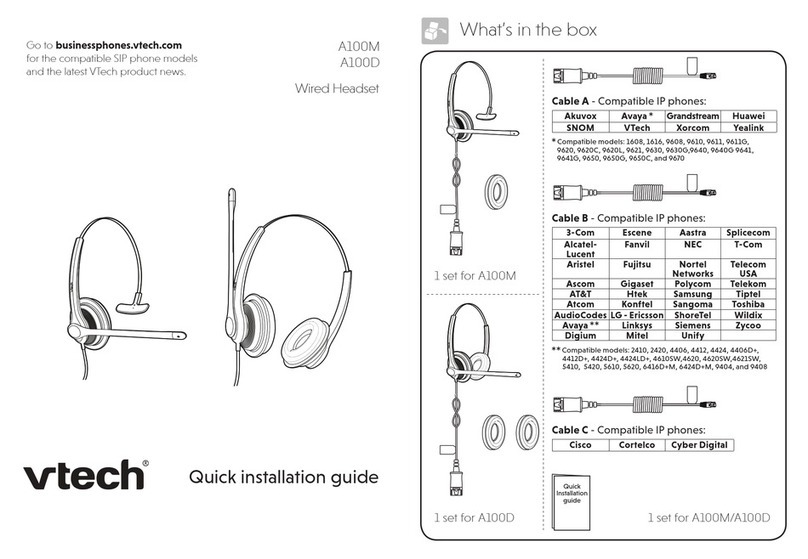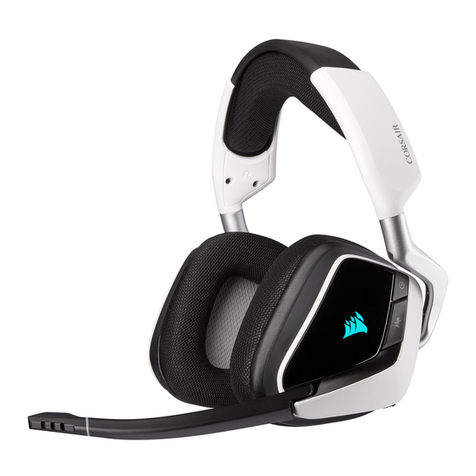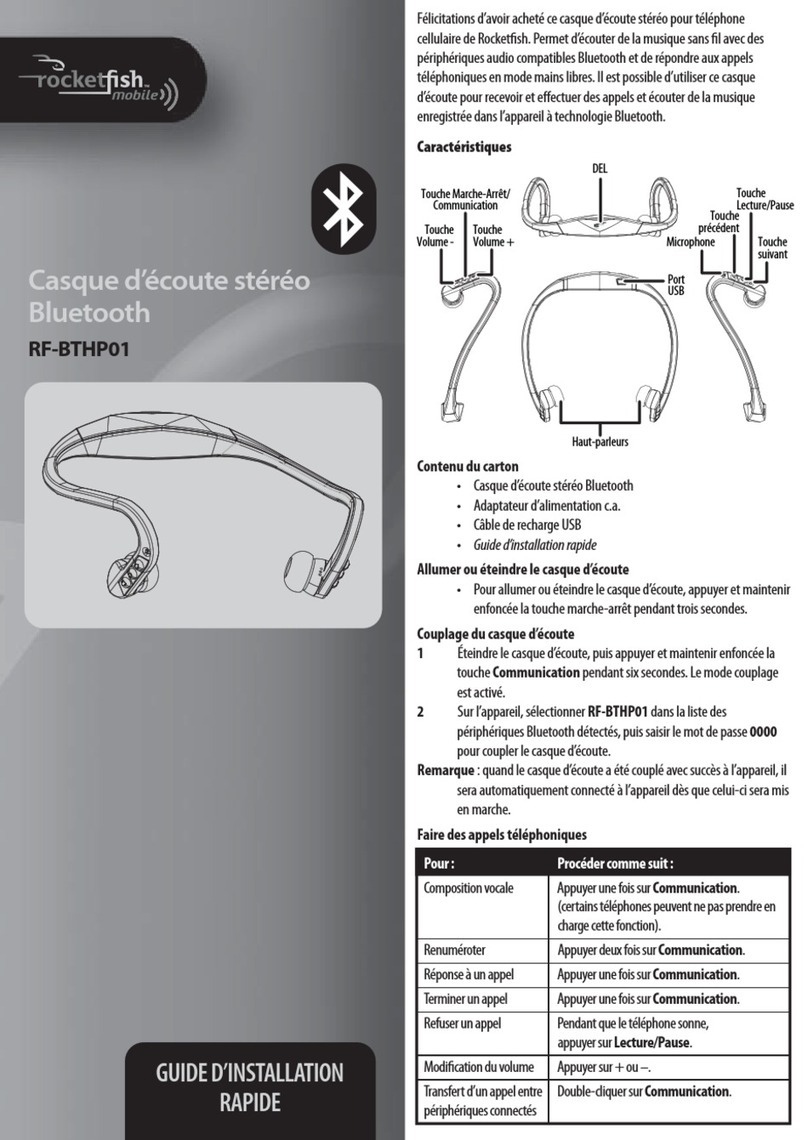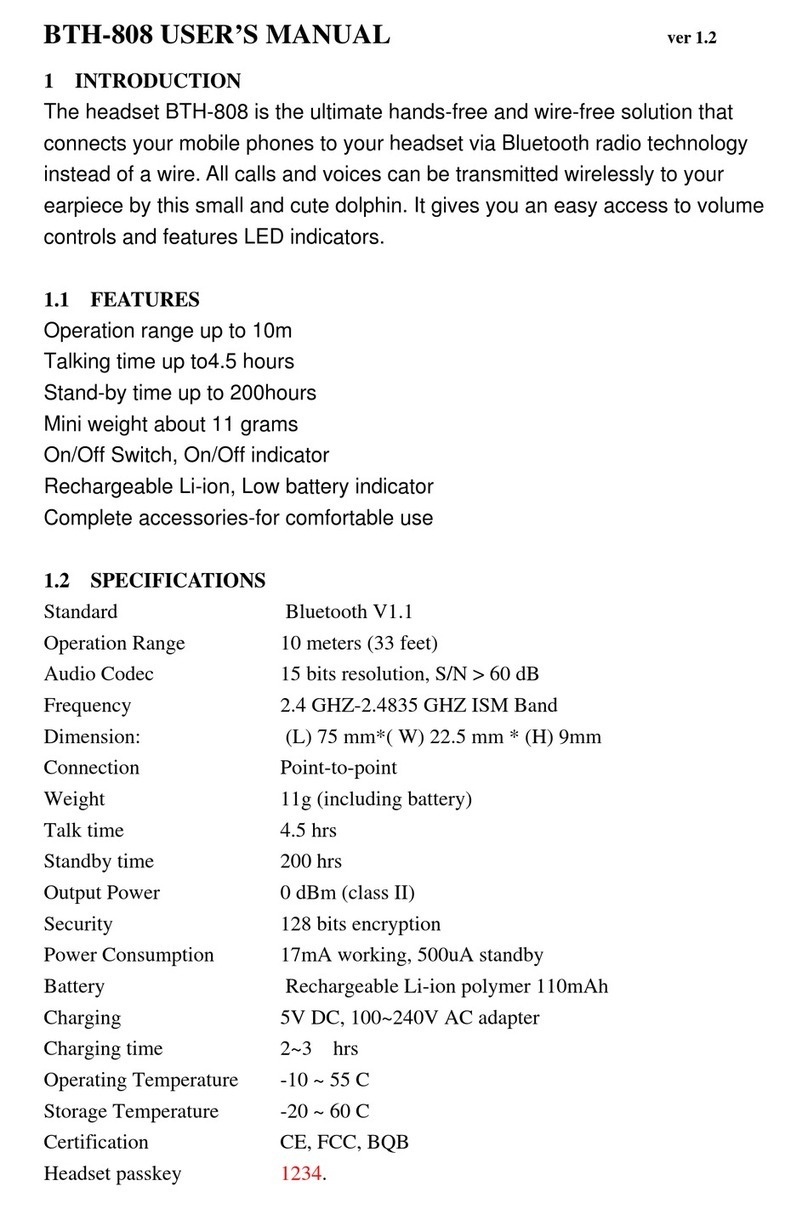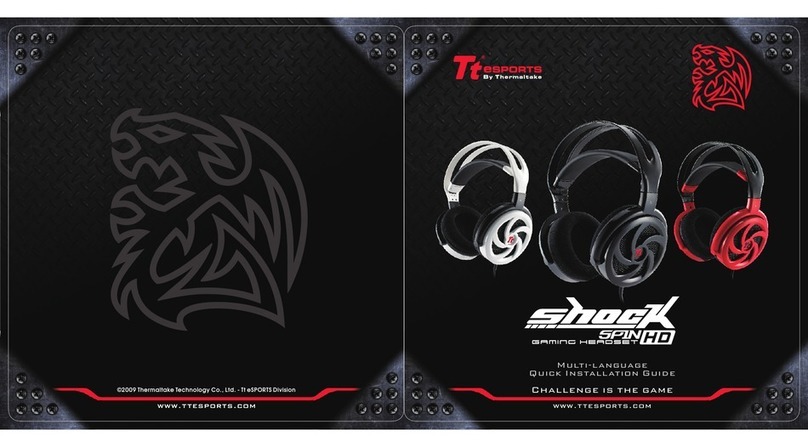Clear-Com MR-202 User manual

MR-202/MR-204
TWO- AND FOUR-CHANNEL HEADSET STATIONS
USER MANUAL

Clear-Com Intercom Systems MR-202/MR-204 Two- and Four-Channel Headset Stations
© Clear-Com Intercom Systems 2000 1Rev. B
Introduction
Congratulations and thank you for choosing this Clear-Com product.
The MR-202 Two-Channel and MR-204 Four-Channel Headset Stations are
powerful, yet user-friendly units that can serve as versatile intercom stations.
Please read this manual completely to better understand the functions of
these products. For questions not addressed in this manual, contact the
dealer or Clear-Com directly. Clear-Com applications support and service
people are ready to help.
Description
The Clear-Com PL-Pro™MR-202 and MR-204 are headset stations ideal for
use in theatres, live performances, industrial environments, and small
television facilities. They feature speech intelligibility in all noise levels and
can be customized through their programmable options.
Selectable, multi-channel talking and/or listening allows the operator to
communicate on one of two (MR-202) or four (MR-204) intercom channels.
The dual-action talk button operates in electronic momentary or latching
mode. The MR-202 and MR-204 offer visual call signaling to attract the
attention of operators. The Remote Mic Kill (RMK) feature on main stations
will turn off any open microphones on these headset stations.
The MR-202 and MR-204 stations accept dynamic headsets, such as the
Clear-Com PL-Pro™or the HS-6 Telephone Headset Series. A sidetone
control allows the operator to vary the level of his voice heard in the headset.
The MR-202 and MR-204 receive 30-V DC power from the Clear-Com
intercom line. They mount in a standard two-gang electrical outlet box. The
extra-thick front panel and compact, surface-mount circuitry results in a small
size and lighter weight package that maintains Clear-Com ruggedness. The
intercom channels connect to a plug-on screw terminal strip.
The optional EB-TW daughter board module can be installed to provide an
interface to two intercom channels on a single microphone cable. Also, the
EB-TW 4-Wire daughter board module is available to allow long-distance
connections using separate pairs of wire for send audio and receive audio.
The EB-4W 4-Wire option supports two-channel operation and may only be
used on the MR-202.
The MR-202 and MR-204 are compatible with all Clear-Com Party-Line
intercoms.

MR-202/MR-204 Two- and Four-Channel Headset Stations Clear-Com Intercom Systems
Rev. B 2© Clear-Com Intercom Systems 2000
Quick Start
1. Unpack the unit and inspect for any damage that may have
occurred during shipping.
2. Connect the intercom lines. If less than the maximum number of
intercom lines are to be connected, link unused intercom inputs
to a connected input with jumper wires.
3. Install the MR-202 or MR-204 into the two-gang outlet box. (For
additional information, refer to the Clear-Com PL-Pro™System
Installation Manual.)
4. Connect the appropriate headset or handset.
5. Set Listen Levels and Sidetones. (Refer to “3—Intercom Level
Control” on page 4 and “4—Sidetone Control” on page 4.)
6. The headset station should now be operating properly.
7. Read the rest of this manual for further information.
Operation
Normal operation of the MR-202 or MR-204 Headset Station only requires the
front-panel controls. The controls located elsewhere on the unit are intended
to be set-and-forget in nature. For intercom operation, set the Listen level
control to the desired level and press the Talk button when talking. Set the
Sidetone control for the desired amount of sidetone in the earphone.

Clear-Com Intercom Systems MR-202/MR-204 Two- and Four-Channel Headset Stations
© Clear-Com Intercom Systems 2000 3Rev. B
Front Panel
The controls, indicators, and connectors found on the MR-204 front panel are
shown in Figure 1 on page 3 and are described by the following text. The MR-
202 front panel is identical except the channel switch has two positions.
FIGURE 1: Front Panel
1—Talk Button and Lamp
The Talk button activates the microphone feed to the selected intercom
channel. The Talk button has a dual action (momentary or latching) depending
upon how the button is pressed. If desired, the latching function can be
defeated using an internal switch. The following describes the various
functions of this button.
• Momentary—Press and hold the Talk button while speaking. Release it
when finished.
• Latching—Press and release the button quickly to latch the Talk
function. Press and release the button again to turn off the Talk
function.
pro
MR-204
R e m o t e
S t a t i o n
PL
Intercom Level
Channel Select
B
A
Call
Talk
Sidetone
2
1
4
C
D
3 5
6

MR-202/MR-204 Two- and Four-Channel Headset Stations Clear-Com Intercom Systems
Rev. B 4© Clear-Com Intercom Systems 2000
• Talk Indication—The associated Talk lamp will illuminate green when
the Talk function is activated.
2—Call Button and Lamp
Pressing the Call button will send a call signal on the selected channel. All the
call lights on that channel will then flash. Call signals can also be sent while
talking if required. The Call lamp will light while the Call button is pressed, or
whenever a call signal is present on the selected channel.
3—Intercom Level Control
Turn this control to set the listen level required on the headset.
4—Sidetone Control
Sidetone is the level of the operator’s voice that heard while talking on the
intercom. Setting a comfortable level of sidetone will ensure that the intercom
line sounds alive and also helps modulate the operator’s voice relative to
other voices on the line.
Use the following procedure to correctly set the Sidetone level control.
1. Set the Intercom Level control to a comfortable level by having
someone talk to the operator from another station.
2. Press the Talk button and speak into the microphone while
turning the Sidetone control slowly back and forth until you hear
your voice at a comfortable level in the headset.
Note: Do not force the trimpot past its stop points. This will damage it.
5—Channel Switch
This switch selects the intercom channel (A, B, C, or D) on which the headset
station is active.
6—Headset Connector
The headset connector is located on the front panel. All Clear-Com headsets
are recommended for use with the MR-202 or MR-204. The Clear-Com PT-4
Push-to-Talk Microphone or the HS-6 Telephone Handset will also plug into
the headset connector. The following is a description of the characteristics of
a suitable headset:
• Mic Type—Dynamic; 150 to 400 ohms impedance; -55 dB output level
• Headphone—Dynamic; 50 to 2000 ohms impedance.
The wiring of the headset is to be as follows:
• Pin 1—microphone ground (shield)
• Pin 2—microphone hot
• Pin 3—headphone ground
• Pin 4—headphone hot.

Clear-Com Intercom Systems MR-202/MR-204 Two- and Four-Channel Headset Stations
© Clear-Com Intercom Systems 2000 5Rev. B
The microphone and headphone wiring in the headset cord must be
individually shielded.
Note: Do not connect Pins 1 and 3 together. Headset extension cords or
headset “Y” cables are not recommended because they may increase
crosstalk between channels.
Internal Adjustments and Connections
The controls and connectors found inside the MR-202 and MR-204 are shown
in the following figure and described by the following text. The jumpers can be
accessed without completely removing the panel from its wall box by
removing the top two screws and loosening the bottom two screws a few
turns. The panel can then be leaned out from the wall. The jumpers will be
accessible as shown in the lower view of Figure 2 on page 5.
FIGURE 2: Internal Adjustments and Connections
View from top
of MR-202
Front Panel
P3 Must be
installed if
no option
P1 Must be
installed if
no option
JB1
JB2
7
89

MR-202/MR-204 Two- and Four-Channel Headset Stations Clear-Com Intercom Systems
Rev. B 6© Clear-Com Intercom Systems 2000
7—Option Jumpers
Two option jumpers, JB1 and JB2, are provided. They should be configured
when the system is set up, but shouldn’t need to be changed during normal
operation.
Note: The default position of the jumpers is in the OPEN (only one pin
connected) position. The function of each jumper is as follows:
JB1—Long Line
If a long cable run is unavoidable and approaches 1,000 ft. or more, set the
Long Line option jumper to the CLOSED (both pins connected) position. The
ability to set a sidetone null depends upon properly setting this jumper.
JB2—Latch Disable
Setting the Latch Disable jumper to the CLOSED (both pins connected)
position will disable the latching function of the Talk button. In this mode, the
Talk button must be held in continuously while the operator is talking.
8—Intercom Line Connection
The MR-202 contains a five-terminal, plug-on connector for intercom line
connection. The MR-204 contains a seven-terminal, plug-on connector for
intercom line connection. This connector is intended to be unplugged from the
circuit board when connecting the intercom line(s), and then plugged back on
when the wiring is completed. If less than the maximum number of intercom
lines are to be connected to the intercom connector, link unused intercom
inputs to a connected input with jumper wires. The connections for each pin
are visible on the circuit board when the connector is unplugged. The pinout
of this connector is as follows:
• Pin 1—(NC)
• Pin 2—Channel A Audio
• Pin 3—Channel B Audio
• Pin 4—Power (+30 VDC)
• Pin 5—Ground (Shield)
• Pin 6—Channel C Audio (MR-204 only)
• Pin 7—Channel D Audio (MR-204 only).

Clear-Com Intercom Systems MR-202/MR-204 Two- and Four-Channel Headset Stations
© Clear-Com Intercom Systems 2000 7Rev. B
FIGURE 3: MR-202 Intercom Wiring
FIGURE 4: MR-204 Intercom Wiring
9—Option Board Jumpers
The two jumper plugs, P1 and P3, must be installed when optional modules
are not used. When the optional 4-Wire or TW Modules are used, both P1 and
P3 must be removed. Save these jumper plugs for possible future.
Note: The MR-202 and MR-204 will not operate without either these jumper
plugs or the optional modules installed.
23
1
MR-202 Intercom
Connector
XLR
Connector
Channel A
Pin 1
23
1
23
1
MR-204 Intercom
Connector
XLR
Connectors
Channel A
Channel B
Pin 1
23
1
23
1
Channel C
Channel D

MR-202/MR-204 Two- and Four-Channel Headset Stations Clear-Com Intercom Systems
Rev. B 8© Clear-Com Intercom Systems 2000
FIGURE 5: MR-202 Block Diagram
EQ/
LIM
Headset
Mic
Sidetone
Null
Call
Light
Intercom
Volume
TW Option
Channel
Switch
Ch. A
Power
Ch. B
Call Send &
Receive
Headset
Output
Mic
Mute
Common
+30 VDC
Ground
Long Line
4-Wire
Input
4-Wire
Output
2-Wire / 4-Wire
Select
Rectifier
16 VAC
Power
Ch. B
Ch. B
Ch. A
Ch. A
4-Wire
Option
Talk
RMK
Microprocessor
Talk
Latch
Disable
Call

Clear-Com Intercom Systems MR-202/MR-204 Two- and Four-Channel Headset Stations
© Clear-Com Intercom Systems 2000 9Rev. B
FIGURE 6: MR-204 Block Diagram
Troubleshooting
•System does not operate. Talk Light does not come on when Talk
button is pressed.
Scenario 1
The MR-202 or MR-204 doesn’t have an intercom connection. If the EB-4W 4-
Wire Option Module is connected, the MR-202 may not be receiving AC
power.
Solution: Check connections and cable.
Scenario 2
The MR-202 or MR-204 has an internal failure.
Solution: Unit requires servicing.
•Headset does not operate. Talk Light comes on when Talk button
is pressed.
Scenario 1
The headset unplugged, the Intercom Level knob is turned all the way down,
or the Channel switch set to unused channel.
Solution: Adjust controls appropriately.
EQ/
LIM
Headset
Mic
Sidetone
Null
Call
Light
Intercom
Volume
Call Send &
Receive
Headset
Output
Mic
Mute Long Line
Talk
RMK
Microprocessor
Talk
Latch
Disable
Call
TW Option
Channel
Switch
Ch. A
Power
Ch. B
Common
+30 VDC
Ground
Ch. C
Ch. D

MR-202/MR-204 Two- and Four-Channel Headset Stations Clear-Com Intercom Systems
Rev. B 10 © Clear-Com Intercom Systems 2000
Scenario 2
Defective headset.
Solution: Test with another headset.
Scenario 3
Plug P3 is missing on circuit board.
Solution: Plug P3 must be installed in the J3 jack if the EB-4W or EB-TW
option is not used.
•Hum or buzz in system
Scenario 1
Inductive pickup caused by close proximity of this headset station or
connected stations to power lines or transformers.
Solution: Relocate the offending unit or wiring. If the cable run is exceptionally
long, consider adding and using the EB-4W 4-Wire Option Module. (Requires
an additional 4-wire interface at the opposite end of the “long run.”)
•System feedback (Acoustical)
Scenario 1
Listen Level control at this station or another station is set too high.
Solution: Adjust.
Scenario 2
Sidetone Null control at this station or another station is not adjusted correctly.
Solution: Adjust. Refer to “Front Panel” on page 3.
Scenario 3
Channel not terminated.
Solution: Set the Main Station or Power Supply termination switch for that
channel to the ON position.
Scenario 4
The Channel switch is set to an unconnected channel.
Solution: If less than the maximum number of intercom lines are to be
connected, link unused intercom inputs to a connected input with jumper
wires.
Scenario 5
A headset extension cord was used.
Solution: Headset extension cords are not recommended because they
increase crosstalk.

Clear-Com Intercom Systems MR-202/MR-204 Two- and Four-Channel Headset Stations
© Clear-Com Intercom Systems 2000 11 Rev. B
•Excessive crosstalk
Scenario 1
High DC resistance in ground return.
Solution: Use heavier cable; add additional conductor(s) to ground return. If
the cable run is exceptionally long, consider adding and using the EB-4W 4-
Wire Option Module.
Scenario 2
Multi-channel cable pairs are not individually shielded.
Solution: Replace cable with individually shielded pairs.
Scenario 3
Headset cables are not wired properly or shielded properly.
Solution: Correct wiring. Use headsets with properly shielded wiring.
• The Call signal does not function.
Scenario 1
Excessive DC loading of intercom line.
Solution: Remove any audio transformers or other equipment which may be
connected across the intercom line. If equipment other than Clear-Com
intercom equipment must be connected to the intercom line, please contact
Clear-Com application or service personnel for advice.
Scenario 2
Far too many terminations on the intercom line.
Solution: Check all main stations and power supplies to make sure each
intercom channel is terminated at only one point.
Scenario 3
Plug P1 missing on circuit board.
Solution: Plug P1 must be installed in the J1 jack if the EB-4W or EB-TW
options are not used.

MR-202/MR-204 Two- and Four-Channel Headset Stations Clear-Com Intercom Systems
Rev. B 12 © Clear-Com Intercom Systems 2000
PARTS LISTS
Parts List for the MR-202/MR-204 Main PCB and Chassis
Capacitors
Value Type Volts Tol. Part # Designator
.01 uF Ceramic Disc 1.4KV 20% 150029 C6
4.7 uF Aluminum NP 50V 150087 C10
.047 uF Metal Film 100V 2% 150123 C19
100 uF Aluminum 35V 150136 C27
22 uF Aluminum 35V 20% 150152 C23
22 uF Tantalum 16V 150032 C24
22 pF Ceramic Disc SMD 50V 5% 151116 C11 C20
47 pF Ceramic Disc SMD 50V 5% 151120 C2 C16
220 pF Ceramic Disc SMD 50V 5% 151128 C22
470 pF Ceramic Disc SMD 50V 5% 151132 C4 C7
.0022 uF Ceramic Disc SMD 50V 10% 151152 C14
.0047 uF Ceramic Disc SMD 50V 10% 151156 C5 C17
.01 uF Ceramic Disc SMD 50V 10% 151160 C28 C32 C33
.047 uF Ceramic Disc SMD 50V 10% 151168 C15
.1 uF Ceramic Disc SMD 50V 10% 151172 C9 C21 C26
.22 uF Ceramic Disc SMD 50V 10% 151176 C12 C18
.47 uF Tantalum SMD 35V 10% 151184 C31 C34
1 uF Tantalum SMD 16V 10% 151185 C3 C13 C30
4.7 uF Tantalum SMD 16V 10% 151189 C8
10 uF Tantalum SMD 25V 10% 151192 C29
Resistors
Value Power Type Tol. Part # Designator
390 OHM 1/4 Carbon Film 5% 410005 R34
1.3K OHM 1/2 Carbon Film 5% 410075 R9
22.1 OHM 1/10 SMD 1% 411230 R5
39.2 OHM 1/10 SMD 1% 411254 R21
100 OHM 1/10 SMD 1% 411293 R22 R29
221 OHM 1/10 SMD 1% 411326 R11
301 OHM 1/10 SMD 1% 411339 R35
432 OHM 1/10 SMD 1% 411354 R15
825 OHM 1/10 SMD 1% 411381 R31
1.00K OHM 1/10 SMD 1% 411389 R18
1.50K OHM 1/10 SMD 1% 411406 R8
2.00K OHM 1/10 SMD 1% 411418 R17
2.74K OHM 1/10 SMD 1% 411431 R14
6.19K OHM 1/10 SMD 1% 411465 R26
6.81K OHM 1/10 SMD 1% 411469 R13
8.25K OHM 1/10 SMD 1% 411477 R36
10.0K OHM 1/10 SMD 1% 411485 R33
12.1K OHM 1/10 SMD 1% 411493 R16

Clear-Com Intercom Systems MR-202/MR-204 Two- and Four-Channel Headset Stations
© Clear-Com Intercom Systems 2000 13 Rev. B
15.0K OHM 1/10 SMD 1% 411502 R12
20.0K OHM 1/10 SMD 1% 411514 R20 R25 R28
100K OHM 1/10 SMD 1% 411581 R23
121K OHM 1/10 SMD 1% 411589 R27
221K OHM 1/10 SMD 1% 411614 R6
475K OHM 1/10 SMD 1% 411646 R24
1.0M OHM 1/10 SMD 5% 411677 R37
10K OHM X4 SMD DIP Isolated1% 416016 R7
47K OHM X4 SMD DIP Isolated1% 416018 R2 R3
100K OHM X4 SMD DIP Isolated1% 416019 R1
470K OHM X4 SMD DIP Isolated1% 416021 R4
Pot 5K TRIMPOT 470063 R19
Pot 5K POT 470081 R30
Diodes and Transistors
Device Description Part # Designator
LED LOW CURRENT GREEN T1 3/4 LED 390021 D6
LED LED, YELLOW, ULTRA BRIGHT T1 3/4 390057 D12
LED LED SMD 0805 RED SMD 391001 D10 D11
IC 7805L POS 5V REGULATOR TO-92 PKG 480088 IC5
Diode BAV70 DUAL DIODE COM CATH... SMD 481019 D4 D13
IC 833 DUAL OPAMP... SMD 481023 IC1 IC2 IC3
Transistor 2222A NPN 40V 600MA... SMD 481026 Q4
Transistor 2907A PNP 60V 600MA... SMD 481027 Q3
Diode BAV99 DUAL DIODE... SMD 481033 D1 D3 D8 D9
Transistor MPSA14 DNPN 30V 300MA... SMD 481038 Q6
Transistor J175 P-CHANNEL JFET... SMD 481056 Q1 Q2
Diode 5.1V 5% ZENER 1/4W... SMD 481061 D5 D7
Transistor MPSA64 DPNP 30V 500MA SMD 481075 Q5
IC MICROPROCESSOR, KB/MR SERIES 710508 IC4
Miscellaneous
Device Description Part # Designator
Connector 5 POS, SCREW TERM. PLUG-IN 5MM 210085 P4
Connector 7 POS, SCREW TERM. PLUG-IN 5MM 210144 P4
XLR 4 PIN M FLUSH MOUNT W/SOLDER CUPS 210286
Switch SB-412 SWITCH KNOB GREY WITH 510030 240024 S1
Pot TRIMPOT SHAFT GREY 240057 R19
Pot KNOB GREY INSERT 240077 R30
Switch ROUND MINIATURE BUTTON BLACK 240081 S3
Switch RECT. MINIATURE BUTTON BLACK 240082 S2
Lens LENS, YELLOW, ROUND FOR T1 3/4 240099 D12
Switch SB-412 SCH#CLA-PV-1X6-MBB-AG-C 510030 S1
Switch DPDT P.B. MINIATURE W/LONG PLUNGER 510107 S3 S2
Wire 4 CONNDUCTOR FLAT CABLE 770017 W1

MR-202/MR-204 Two- and Four-Channel Headset Stations Clear-Com Intercom Systems
Rev. B 14 © Clear-Com Intercom Systems 2000
FIGURE 7: Main PCB Component Layout

© Clear-Com Intercom Systems 2000 15 Rev. B
FIGURE 8: MR-204 Main PCB

MR-202/MR-204 Two- and Four-Channel Headset Stations Clear-Com Intercom Systems
Rev. B 16 © Clear-Com Intercom Systems 2000
This page is a place holder.

Clear-Com Intercom Systems MR-202/MR-204 Two- and Four-Channel Headset Stations
© Clear-Com Intercom Systems 2000 17 Rev. B
Technical Specifications
Headset Microphone Pre-Amp
Input Type: Dynamic
Impedance: 1k ohms
Input Level: -55 dBV nominal; -10 dBV max.
Gain from headset
mic to intercom line: +41 dB
Pre-Amp Response Curve
Frequency Response: 250 Hz to 12 kHz, contoured for intelligibility
Limiter Range: 20 dB
Headphone Amplifier
Load Impedance Range: 50 ohm to 2k ohm
Output Level: at least +20 dBV across 600 ohm
Distortion: < 0.2% THD at 1 kHz
Frequency Response: 200 Hz to 15 kHz, ±3 dB
Gain from intercom line: +37 dB
Power Output: 110 dB SPL (typical)
Power Requirements
Voltage: 30-VDC standard unit; 16 to 18 VAC with 4-Wire Option
Module
Current: 30 mA average
Internal Connectors
Intercom: Five-position, plug-on screw terminals
AC Power
(4-Wire Option Module): Two-position, plug-on screw terminals
Internal Controls
(2) Option jumpers
Front Panel Connectors
Headset: (1) XLR-4M
Front Panel Controls and Indicators
(1) Intercom volume control; (1) Sidetone control; (1) Talk button; (1) Call button; (1)
Channel selector; (1) Talk LED; (1) Call LED

MR-202/MR-204 Two- and Four-Channel Headset Stations Clear-Com Intercom Systems
Rev. B 18 © Clear-Com Intercom Systems 2000
Environmental
32 to 122 F (0 to 50 C)
Dimensions 4.625 in. W x 4.5 in. H x 1.75 in. D (117 mm x 114 mm x 44 mm)
Weight 0.52 lbs. (0.23 kg)
Notice About Specifications
While Clear-Com makes every attempt to maintain the accuracy of the information
contained in its product manuals, that information is subject to change without notice.
Performance specifications included in this manual are design-center specifications and
are included for customer guidance and to facilitate system installation. Actual operating
performance may vary.
MR-202/MR-204 Manual P/N 810256
© 2000 Clear-Com Intercom Systems
All Rights Reserved

Clear-Com Intercom Systems MR-202/MR-204 Two- and Four-Channel Headset Stations
© Clear-Com Intercom Systems 2000 19 Rev. B
Clear-Com Limited Warranty
The Clear-Com warranty does not cover any defect, malfunction, or failure
caused beyond the control of Clear-Com, including unreasonable or negligent
operation, abuse, accident, failure to follow instructions in the manual,
defective or improper associated equipment, attempts at modification and
repair not authorized by Clear-Com, and shipping damage. Products with
their serial numbers removed or defaced are not covered by this warranty.
This warranty is the sole and exclusive express warranty given with respect to
Clear-Com products. It is the responsibility of the user to determine before
purchase that this product is suitable for the user's intended purpose.
Any and all implied warranties, including the implied warranty of
merchantability are limited to the duration of this express limited warranty.
Neither Clear-Com nor the dealer who sells Clear-Com products is liable for
incidental or consequential damages of any kind.
For your own records fill in the information below:
Model No Serial No.
Date Purchased
Purchased from (dealer)
Address
City State ZIP
Factory Service
All equipment returned for repair must be accompanied by documentation
stating the return address, telephone number, date of purchase, and a
description of the problem.
Note: Do not return any equipment to the factory without first obtaining a
Return Authorization Number.
Send equipment to be repaired to:
Customer Service Department
Clear-Com Intercom Systems
4065 Hollis Street
Emeryville, CA 94608-3505
Telephone: (510) 496-6666
Fax: (510) 496-6601
Warranty Repairs
If in warranty, no charge will be made for the repairs. Equipment being
returned for warranty repair must be sent prepaid and will be returned
prepaid.
This manual suits for next models
1
Table of contents
Other Clear-Com Headset manuals
